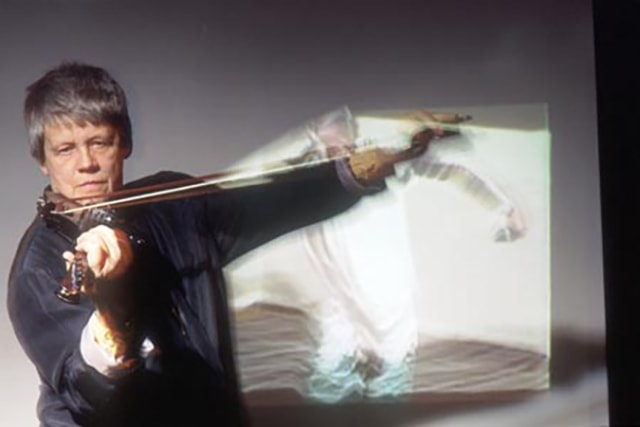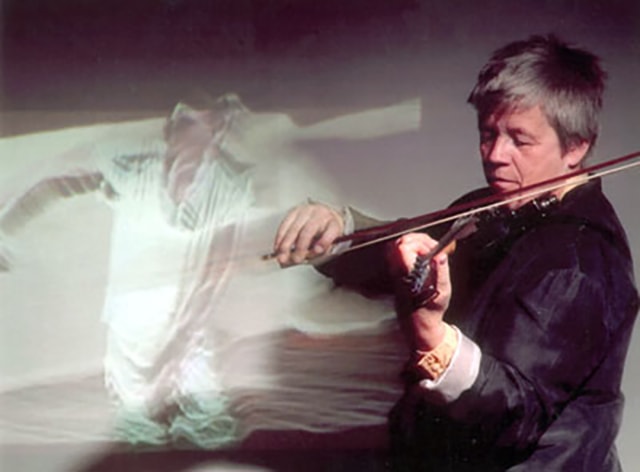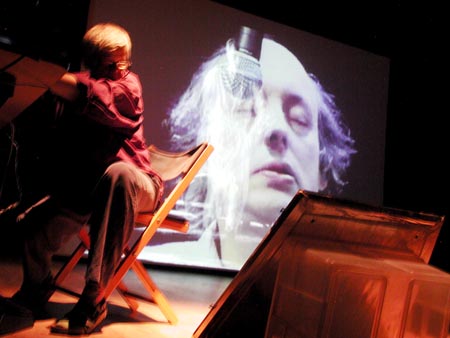title
Violin Power
artist
Steina
intro
Steina’s Violin Power is, at its core, a study of the relationship between music and the electronic image. During a performance of Violin Power, Steina’s violin becomes an image generating tool, through which she can control image sequences.
With experiments dating back to 1970, the work has evolved and developed in relation to new technology. Since 1992, the acoustic demonstrations of the work were replaced with performances that used a 5-string ZETA violin with MIDI output.
In 1997, when Steina was artistic co-director of STEIM, she developed the Image/ine software in collaboration with Tom Demeyer, which allowed for real-time video manipulation during her Violin Power performances.
biography artist
Steina (Reykjavik, Iceland, 1940) is a classically trained violinist who has been working with video since 1969. Her music education greatly influenced her work with images, approaching the moving image in the same way she approaches playing the violin. Her work includes multichannel video installations and audio-visual performances. In 1971 she co-founded The Kitchen, an Electronic Media Theater in New York, together with her husband Woody Vasulka. Together, they were pioneers in the field of video art, focusing on experimenting with audio-visual relationships. Steina has performed, and her work has been shown, all over the world, including at the San Francisco Museum of Modern Art, in the Icelandic Pavilion at the 1997 Venice Biennale, and at art, music, and technology festivals.
keywords
violin, midi, audiovisual, performance, software, live editing, STEIM, Image/ine, sound art
images
[caption id="attachment_430" align="alignnone" width="640"] Steina, Violin Power, 1997. Image from: http://vasulka.org/Steina/Steina_ViolinPower/PBIG_ViolinPower02.html.[/caption]
[caption id="attachment_429" align="alignnone" width="640"]
Steina, Violin Power, 1997. Image from: http://vasulka.org/Steina/Steina_ViolinPower/PBIG_ViolinPower02.html.[/caption]
[caption id="attachment_429" align="alignnone" width="640"] Steina, Violin Power, 1997. Image from: http://www.vasulka.org/Steina/Steina_ViolinPower/ViolinPower.html[/caption]
[caption id="attachment_1026" align="alignnone" width="450"]
Steina, Violin Power, 1997. Image from: http://www.vasulka.org/Steina/Steina_ViolinPower/ViolinPower.html[/caption]
[caption id="attachment_1026" align="alignnone" width="450"] Steina, Violin Power, 1997. Image from: http://www.vasulka.org/Steina/Steina_ViolinPower/PBIG_ViolinPower03.html.[/caption]
Steina, Violin Power, 1997. Image from: http://www.vasulka.org/Steina/Steina_ViolinPower/PBIG_ViolinPower03.html.[/caption]
 Steina, Violin Power, 1997. Image from: http://vasulka.org/Steina/Steina_ViolinPower/PBIG_ViolinPower02.html.[/caption]
[caption id="attachment_429" align="alignnone" width="640"]
Steina, Violin Power, 1997. Image from: http://vasulka.org/Steina/Steina_ViolinPower/PBIG_ViolinPower02.html.[/caption]
[caption id="attachment_429" align="alignnone" width="640"] Steina, Violin Power, 1997. Image from: http://www.vasulka.org/Steina/Steina_ViolinPower/ViolinPower.html[/caption]
[caption id="attachment_1026" align="alignnone" width="450"]
Steina, Violin Power, 1997. Image from: http://www.vasulka.org/Steina/Steina_ViolinPower/ViolinPower.html[/caption]
[caption id="attachment_1026" align="alignnone" width="450"] Steina, Violin Power, 1997. Image from: http://www.vasulka.org/Steina/Steina_ViolinPower/PBIG_ViolinPower03.html.[/caption]
Steina, Violin Power, 1997. Image from: http://www.vasulka.org/Steina/Steina_ViolinPower/PBIG_ViolinPower03.html.[/caption]
year
1969-1978
premiere
This version of Violin Power, which uses the ZETA midi violin and the
Image/ine software was developed at STEIM in 1997.
software
Image/ine
functionality
The Violin Power series is a study of the relationship between music and electronic image. During the Violin Power performance, Steina controls video and image sequences with the ZETA violin, transforming it into an image generating tool. The sounds, movements, and vibrations of the violin affect the sculptural patterns and images that are seen in live performances and their video documentation.
In addition to random access, speed, and direction, the Image/ine software had a wide variety of video effects and memory locations. For performances, Steina chose video clips as much for the sound as the video content. As a computer-based tool, Image/ine allowed for a wider range of connective possibilities and an increased potential for both improvisation and control. By using the Image/ine software to create sculptural forms from her own bodily movements, Steina explores space within the video frame.
part of collection
Berg, LIMA
production
Violin Power is an evolving work, with experiments dating back to 1969. In 1991 Steina began to use a 5-string ZETA violin with a MIDI output, which gave her a wider set of programs to work with and more control over her performance. The ZETA Violin is programmed so that each string controls a specific function within the MIDI controller. In 1997, while serving as artistic co-director at STEIM (Studio for Electronic Instrumental Music) in Amsterdam, The Netherlands, Steina collaborated with Tom Demeyer on the Image/ine software, which she began to use in her Violin Power performance. Image/ine was the first piece of software for desktop computers that gave users the ability to manipulate uncompressed video in real time; proving that real-time video manipulation was possible.
“When initially developed in 1996, Image/ine performed real-time capture, processing and playback of video on a Macintosh PowerPC 8600 containing the stock video i/o card.Though it was the first software of its kind, development has stopped and many aspects of image/ine have now been incorporated into the software Isadora, written by Marc Coniglio.”1
hardware
Zeta midi violin, Model ZETA VC-225
IVL Technologies ZETA MIDI Controller, model PR 7005
IVL foot switch, Model MSF-40
Digitech Harmony Processor, DHP-55
Lexicon LXP-5 Unit with a foot switch
Video Laser Disc player, Pioneer VLD-8000
Program 12 inch laserdisk
AST laptop computer, M 501207-101
PC Music Maker Model HRS 3000
technical specs
“Image/ine is a Macintosh program that allows a user to manipulate visual source material in a live performance environment. Video sampling and playback, keying, displacement and other effects are available with video (live and recorded), QuickTime movies, text, scanned images, image files with alpha channels. Unlike digital video editing programs such as Adobe Premiere, Image/ine works in real time. There is no compression slowdown, no rendering time - the digital filtering effects are immediate and controllable through Midi.”2
intention artistquote by artist
quote
In this interview with Steina, she discusses the process of developing the Image/ine software together with Tom Demeyer and her dislike of rendering: vimeo.com3
“The eighties were ripe with rumors that the Japanese were collaborating with American software engineers on a unifying interface where a controller, typically a keyboard, could be connected to play another instrument. The name of this phenomena was Musical Instrument Digital Interface or MIDI. Eventually MIDI could interface anything to everything, including our videocassette tape recorder, and in the early nineties we connected my acoustic violin to a “pitch to MIDI” device. It was fun, but limited fun because I could move the tape only a few meters, back and forth or faster and slower. If I however had a laser disc player and MIDI violin, I could with a stroke of the bow jump to various locations, somewhat akin to live editing as a performance. After performing this way for a few years, I landed in 1996 a co-directorship at STEIM (the studio for electro-instrumental music) in Amsterdam, which in those years was very involved in interfacing MIDI to acoustic instruments. When I arrived, there already was a MIDI/VIDEO software being written by Tom Demeyer, initially named Image/ine and later IMX. In addition to random access, speed and direction, this software gave me a plethora of video effects and memory locations. The clips in my performances are selected as much for the sound as video content, and are a mix between prepared and improvised play.”4
influence
The collaboration between Steina and Tom Demeyer, which resulted in the creation of the Image/ine software has had a lot of influence on performance, real-time video manipulation, and computer / instrument interfaces.
STEIM promoted the Image/ine software and invited video artists to visit and take a look7. A number of artists have used the Image/ine software in their work: multi-disciplinary artist Lisa Moren used it for her interactive video book la_alma (1999)8; NoiseFold, comprised of David Stout and Cory Metcalf, were early adopters of the Image/ine platform for developing their own work; and Clay Chapin was an early adopter of the software and ran an online user group for the program.9
In a letter in 2008, asking for the re-evaluation of STEIM’s funding, Steina wrote that while an artist-in-residence at STEIM in 1997, Mark Coniglio was so inspired by Image/ine that he decided to write the Isadora dance software. She also notes that Jitter was developed in response to Image/ine. As David Stout writes, “IMAGE/ine10 has been acknowledged by other programmers who have developed a number of related applications including NATO, PD, Isadora, Processing and Jitter.”11
The Kitchen, founded by Steina and Woody Vasulka, was also a hotbed of video performance, with many notable alumni that were influenced by the experimentation at the intersection of music and image that happened there.
context
LITERATURE
Dubbin, Melissa, and Aaron S Davidson. “Steina / Unified Medium, Image from Sound, Sound from Image, 'Violin Power', MIDI Violin, Spontaneity and Play / 1997.” Vimeo, 26 Nov. 2018, vimeo.com.
Flint, Rob. “Film, Video, and Digitality: An Analysis of Cultural Form in Time-based Media.” University of Arts, London, 2004. ualresearchonline.arts.uk
Liberovsky, Katherine, et al. “Improvisatory Live Visuals: Playing Images like a Musical Instrument.” Université du Québec à Montréal, September 2004. archipel.uqam.ca
Norberg, Björn and Jonathan Habib Engqvist. “The Nordic Pioneers of New Media Arts.” Ars HYPERMEDIA, Winter 2009, pp.68-93.
Røed, Ellen Johanne. “SKYVELÆRE: Critical Reflection on Artistic Results of a Fellowship Project in Artistic Research.”Norwegian Artistic Research Fellowship Programme, Bergen Academy of Art and Design, 2014. kmd.uib.no (pdf)
Sa, Adriana de Almeida Portela Viana De. “A Perceptual Approach to Audio-Visual Instrument Design, Composition and Performance.” Goldsmiths, University of London, 2016. research.gold.ac.uk (pdf)
Stout, David. “Analog Video / Digital Antecedent - The Pioneering Work of Woody Vasulka and Steina.” academia.edu.
part of active discussion
In the 2018 exhibition at the Pori Art Museum, “Steina & Woody Vasulka, Art of Memory, Works from 1969 to 2000”, the website states that “[t]he Vasulkas’ methods anticipated the virtual modes of image-making that are dominant today,” pointing to an ongoing and active influence.12
scene artists institutes
The Kitchen, STEIM, Berg, MonteVideo/NIMk/LIMA Amsterdam
footnote
1 Editors note on video interview with Steina Vasulka. Source: Melissa Dubbin and Aaron S. Davidson, Steina / Developing Image/Ine with Tom Demeyer at STEIM, Interest in Displacement and Morphing, Dislike of Rendering / 1997. Vimeo, 30 Nov. 2018, vimeo.com. 2 “Image/Ine.” V2_Institute For the Unstable Media, 3 Nov. 2011, v2.nl/archive. 3 Melissa Dubbin and Aaron S. Davidson. Steina / Developing Image/Ine with Tom Demeyer at STEIM, Interest in Displacement and Morphing, Dislike of Rendering / 1997. Vimeo, 30 Nov. 2018, vimeo.com. 4 “Steina Vasulka.” RAFLOST, 10 May 2010, raflost.is/steina-vasulka. 5 “Steina & Woody Vasulka / Art of Memory / Works from 1969 to 2000.” Pori Art Museum, poriartmuseum.fi. 6Lenka Dolanová, Woody Vasulka: Dialogue with the (Demons in the) Tool: Steina and Woody Vasulka. NAMU and JSAF / Jihlava International Documentary Film Festival, Oct. 2011. chronicle.okno.be (pdf)
7 “MAX Digest - 31 Mar 1997 to 1 Apr.”Max Archive , 4 Apr. 1997, max-archive.bek.no. 8 Lisa Moren, lisamoren.com. 9 “For Bunita Marcus.” Clay Chaplin, claychaplin.com. 10 Steina Vasulka, “STEIM.” 25 Apr. 2008, Santa Fe , New Mexico, steim.org/archive. 11 David Stout,“Analog Video / Digital Antecedent - The Pioneering Work of Woody Vasulka and Steina.”Academia.edu, academia.edu. 12 “Steina & Woody Vasulka / Art of Memory / Works from 1969 to 2000.” Pori Art Museum, poriartmuseum.fi.
Annie Abrahams
Livinus van de Bundt & Jeep van de Bundt
Driessens & Verstappen (Erwin Driessens and Maria Verstappen)
Yvonne le Grand
Edward Ihnatowicz
JODI (Joan Heemskerk & Dirk Paesmans)
Bas van Koolwijk
Lancel/Maat (Karen Lancel and Hermen Maat)
Jan Robert Leegte
Peter Luining
Martine Neddam
Marnix de Nijs and Edwin van der Heide
Dick Raaijmakers
Joost Rekveld
Remko Scha
Jeffrey Shaw
Debra Solomon
Steina
Peter Struycken
Michel Waisvisz